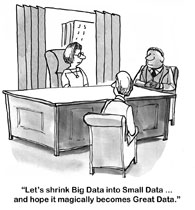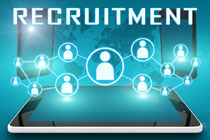 In the January/February issue of HR Magazine, Josh Bersin with Deloitte, makes nine predictions of “what’s in store for HR in 2015.” This is part seven of a series of nine articles looking at each of these predictions.
In the January/February issue of HR Magazine, Josh Bersin with Deloitte, makes nine predictions of “what’s in store for HR in 2015.” This is part seven of a series of nine articles looking at each of these predictions.
A sign on Albert Einstein’s door read: “Not everything that can be counted counts, and not everything that counts can be counted.” “Big data” is all the rage today, but does it really need to be all that big (think Neilson ratings) and is it really all that useful? Certainly data, statistics, and analytics are not new tunes that just hit the charts, particularly in the wonderful world of sports. Today we are using data, in both large and small businesses, to measure everything from behaviors such as a doctor’s bedside manner to data that could keep older drivers behind the wheel longer to data that reveals that employees who blog are happier Analytics involving more “clear cut” information such as economics, college admissions, and budgets will continue to prove useful. In addition, HR is now learning to use data for workforce planning. Moreover, data may help HR to obtain more of the business partner status it has been desiring for years.
It’s no secret that HR has not enjoyed a good reputation over the years and it has been waiting to be invited to “a seat at the table.” However, some wonder why HR has not “claimed” its seat at the table, by making itself more of a business partner. Unfortunately, many do not know where to begin to make such a transition happen. Analytics may be just the ticket. Let’s look at how analytics are changing the face of the workforce first.
Talent Management,, Talent Analytics,
Read more: Play It Again Sam – Looking Through HR’s Crystal Ball – Prediction Seven of Nine – Talent...
 To begin, it’s wise to determine if your team needs a teambuilding program in the first place. Conducting a teambuilding session because, “We haven’t done one in a while.” or holding teambuilding sessions such as a romp at the local bowling alley or flying across the forest on a zip line are not all that successful. Moreover, these really don’t work if they are supposed to be seen as a reward for hard work. In addition, there are many more creative ways to help build and bond your team. So before jumping in to teambuilding willy nilly, here are some questions to ask that will help determine if a teambuilding session is needed.
To begin, it’s wise to determine if your team needs a teambuilding program in the first place. Conducting a teambuilding session because, “We haven’t done one in a while.” or holding teambuilding sessions such as a romp at the local bowling alley or flying across the forest on a zip line are not all that successful. Moreover, these really don’t work if they are supposed to be seen as a reward for hard work. In addition, there are many more creative ways to help build and bond your team. So before jumping in to teambuilding willy nilly, here are some questions to ask that will help determine if a teambuilding session is needed. So now you’ve identified your high potentials, how are you planning on keeping them and why is it important? First let’s look at what high potentials can do for the organization.
So now you’ve identified your high potentials, how are you planning on keeping them and why is it important? First let’s look at what high potentials can do for the organization. After writing about high potentials in the nine part “Play it Again, Sam” series and having a coaching client who is taking a hard look at identifying high potentials in her organization, I wanted to explore this topic a bit further.
After writing about high potentials in the nine part “Play it Again, Sam” series and having a coaching client who is taking a hard look at identifying high potentials in her organization, I wanted to explore this topic a bit further. In the January/February issue of HR Magazine, Josh Bersin with Deloitte, makes nine predictions of “what’s in store for HR in 2015.” This is part nine of a series of nine articles looking at each of these predictions.
In the January/February issue of HR Magazine, Josh Bersin with Deloitte, makes nine predictions of “what’s in store for HR in 2015.” This is part nine of a series of nine articles looking at each of these predictions. In the January/February issue of HR Magazine, Josh Bersin with Deloitte, makes nine predictions of “what’s in store for HR in 2015.” This is part eight of a series of nine articles looking at each of these predictions.
In the January/February issue of HR Magazine, Josh Bersin with Deloitte, makes nine predictions of “what’s in store for HR in 2015.” This is part eight of a series of nine articles looking at each of these predictions. In the January/February issue of HR Magazine, Josh Bersin with Deloitte, makes nine predictions of “what’s in store for HR in 2015.” This is part seven of a series of nine articles looking at each of these predictions.
In the January/February issue of HR Magazine, Josh Bersin with Deloitte, makes nine predictions of “what’s in store for HR in 2015.” This is part seven of a series of nine articles looking at each of these predictions. In the January/February issue of HR Magazine, Josh Bersin with Deloitte, makes nine predictions of “what’s in store for HR in 2015.” This is part six of a series of nine articles looking at each of these predictions.
In the January/February issue of HR Magazine, Josh Bersin with Deloitte, makes nine predictions of “what’s in store for HR in 2015.” This is part six of a series of nine articles looking at each of these predictions. In the January/February issue of HR Magazine, Josh Bersin with Deloitte, makes nine predictions of “what’s in store for HR in 2015.” This is part five of a series of nine articles looking at each of these predictions.
In the January/February issue of HR Magazine, Josh Bersin with Deloitte, makes nine predictions of “what’s in store for HR in 2015.” This is part five of a series of nine articles looking at each of these predictions.